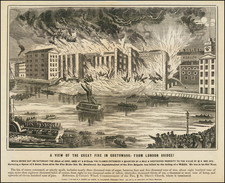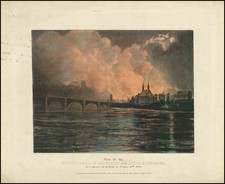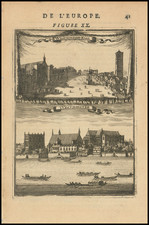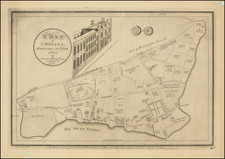An Early Map of the Marylebone Station, with Lord's Cricket Ground and Public Bar!
Rare large format map of the Marlyebone Train Station and surrounding part of St. Marylebone Parish, immediately west of Regent's Park in London.
The map locates numerous local landmarks, including the Lord's Cricket Grounds, Marylebone Cricket Club, Abbey Road, the Horse Stables near the station, Hospital of St. John & St. Elizabeth, St. Paul's Church, Ornamental Gardens, Hotel Great Central, etc.
The map, shown at a Scale of 88 to an inch, was drawn by Henry Fowler F.S.I. Surveyor.
Sir Henry Fowler
The map was the work of Sir Henry Fowler, KBE (29 July 1870 – 16 October 1938), the a chief mechanical engineer of the Midland Railway and subsequently the London, Midland and Scottish Railway.
Fowler attended Mason Science College (which became the University of Birmingham) between 1885 and 1887 where he studied metallurgy. He served an apprenticeship under John Aspinall at the Lancashire and Yorkshire Railway (L&YR)'s Horwich Works from 1887 to 1891. Fowler was a elected as a Whitworth Exhibitioner in 1891. He then spent four years in the Testing Department under George Hughes, whom he succeeded as head of the department.
Between 1895 and 1900 he was gas engineer of the L&YR, moving in June 1900 to the Midland Railway (MR). In November 1905 he became assistant works manager, being promoted to works manager two years later. In 1909 he succeeded Richard Deeley as chief mechanical engineer (CME) of the MR.
History of the Marylebone Train Station
The early history of Marylebone is tied into the Great Central Railway (GCR)'s Great Central Main Line (GCML) extension into London. When Sir Edward Watkin became chairman of the Manchester, Sheffield and Lincolnshire Railway (MS&LR) in 1864, the line was not particularly lucrative as it had no direct connection to London. Watkin was unhappy about transferring traffic to the Great Northern Railway, and when he became chairman of the Metropolitan Railway in 1872, he decided to build a dedicated line between the MS&LR and Central London.
The approach to Marylebone was the last section of the Great Central Main Line to be built. Progress was delayed in the 1890s because of objections, particularly as the line would pass through Lord's, the principal cricket ground in London and home of Marylebone Cricket Club. Watkin promised that Lord's would not be disrupted by the railway construction, and an act of Parliament to complete the line was passed on 28 March 1893. The station was built on a 51-acre site around Blandford and Harewood Squares, west of Regent's Park.
Watkin resigned the chairmanship in 1894 following ill health, and was replaced by Lord Wharncliffe. The approach to the station through Lord's was achieved by a cut-and-cover tunnel constructed between September 1896 and May 1897, avoiding the cancellation of any cricket.
The station opened to coal traffic in July 1898 and to passengers on 15 March 1899. It was the terminus of the GCR's London extension main line – the last major railway line to be built into London until High Speed 1.










![[The Illustrated London News. April 17, 1869] Proposed Sites for the New Law Courts.](https://storage.googleapis.com/raremaps/img/small/80985.jpg)

![[View of London, etc.] Abilltung wie königliche Maistät in Engelandt Die Artickel Dess Spanischen Heyraths Jur: Bekreftiget Anno 1623](https://storage.googleapis.com/raremaps/img/small/90777.jpg)

